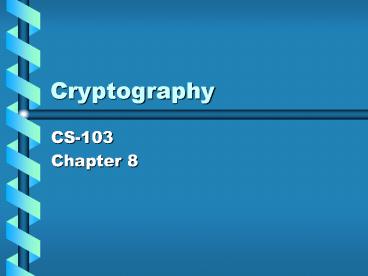Cryptography PowerPoint PPT Presentation
Title: Cryptography
1
Cryptography
- CS-103
- Chapter 8
2
History
- Humans have been devising systems to encode
information for at least 4000 years. - The original message is in plaintext while the
encoded message is in ciphertext.
3
History Some Encoding Schemes
- Caesar Shift
- Substitution Cipher
- Vigenere Cipher
- One-Time Pad Cipher
- Enigma
- Public Key Cryptography
4
History Caesar Shift
- First used by Julius Caesar
- Uses a simple alphabetic shift
- Plaintext is shifted a certain number of letters
forward or backward
- Example
- Plaintext - AUTO
- Ciphertext BVUP
- Alphabet is shifted on letter forward AB, BC,
etc.
5
Caesar Shift (Contd)
- This type of cipher is relatively easy to break
by trial-and-error. - Recipient must only know the number of places the
alphabet has been shifted. - Still used during the Civil War to send messages
on the battlefield.
6
History Substitution Cipher
- Encoded letters are randomly scrambled.
- Recipient must know the scrambled alphabet.
- May use a key word to begin scrambling.
- Alphabet
- A B C D E F G H
- Scrambled
- C O D E A B F G
- Plaintext
- FACE
- Ciphertext
- BCDA
7
Substitution Cipher (Contd)
- Because letter frequencies in various languages
are well established, this type of cipher is
relatively easy to break. - Newspapers often contain an encoded puzzle that
uses this method of encryption.
8
Substitution Cipher (Contd)
- If the alphabet is randomly scrambled, the
recipient must know the entire substitution
scheme. - If a keyword is used, the recipient must only
know the keyword to complete the substitution
scheme.
9
History Vigenere Cipher
- Modification of the Substitution Cipher
- The alphabet is re-scrambled for each letter of
the plaintext message - Requires a keyword or phrase to start the
substitution sequence - Requires use of a Vigenere Table
10
Vigenere Cipher (Contd)
- Considered unbreakable for several centuries.
- Eventually Babbage, Kasiski, and Kerchoff devised
a method to break the Vigenere cipher. - Be sure you understand how this cipher works.
Use the website provided in the on-line text.
11
History One-Time Pad Cipher
- Modification of the Vigenere Cipher
- Message length is limited to some prescribed
number of characters - Key is longer than any message
- Each key is used only once and then destroyed.
12
One-Time Pad Cipher (Contd)
- Recipient must know which pad and key were used
to encode the message - Once the message is decoded, the key and the
pad on which it was recorded are destroyed - The pad and key are never used again
13
One-Time Pad Cipher (Contd)
- This cipher method was used by many governments
for diplomatic communications - Since each pad was used only once, the
Babbage-Kasiski-Kerchoff method could not be used
to decipher messages - Drawback both sender and recipient had to know
the number of the pad being used to encode the
message
14
History The Engima Machine
- Germany developed this encoding device during
WWII - England enlisted some of the greatest
mathematicians of the time to attempt to break
the code - Alan Turing, the father of modern computer
science was part of this team - Enigma code was not broken until a German
submarine was captured and a machine and code
book were found
15
History Public-Key Cryptography
- Computers ushered in a new age of cryptography
- Increased electronic transmission of sensitive
data required new levels of security - Requires the use of two keys a public key and a
private key
16
Public-Key Cryptography (Contd)
- Public Key
- Known to everyone who wishes to send an encoded
message to a recipient - Cant be used to decode message
- Private Key
- Known only to the recipient
- Can only be used to decode a message
17
Public-Key Cryptography (Contd)
- Diffie, Hellman, and Merkle discovered and
published the key concepts for this method - Rivest, Shamir, and Adleman devised an algorithm
that could be used to implement the idea - The RSA algorithm has become the foundation for
modern electronic security methods
18
Public-Key Cryptography (Contd)
- RSA method is based upon the idea that some
mathematical processes are easy to implement but
almost impossible to reverse. - Multiplying two large prime numbers is easy
- Factoring this product to find the original prime
numbers is very difficult - Current methods use products of more than 300
digits.
19
Public-Key Cryptography (Contd)
- As computer speeds increase and new methods of
factoring large numbers are discovered, perhaps
the RSA method will someday be broken.
20
TheEnd

